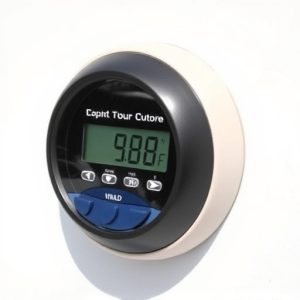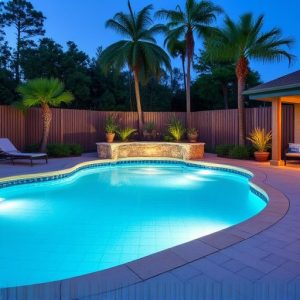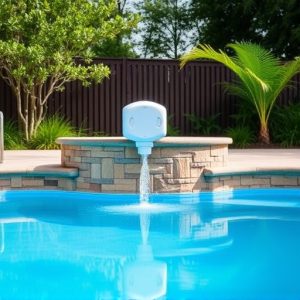Inground Pool Safety: A Guide to Swimming Pool Alarm Systems
Swimming pool alarms are essential safety devices for inground pools, designed to detect unauthoriz…….
Swimming pool alarms are essential safety devices for inground pools, designed to detect unauthorized or accidental access and alert property owners to potential dangers. These alarms come in various forms, including surface motion detectors, wave disturbance sensors, and underwater motion detectors, each tailored to enhance pool security. Proper selection, installation, and regular maintenance are crucial for their effectiveness; factors like pool size, surrounding activity, and specific safety needs should guide the choice of alarm type. It's also vital to configure sensitivity and volume settings accurately to ensure the alarm can differentiate between normal activities and potential safety breaches. Regular testing and upkeep, as recommended by manufacturers, are necessary to maintain the alarm's reliability, especially considering environmental influences that could affect performance. By adhering to these practices, homeowners can rely on swimming pool alarms for inground pools to provide a heightened level of safety and peace of mind around their pool areas.
Swimming pool alarms for inground pools serve as a critical layer of safety, safeguarding against accidental drownings. This article delves into the essentials of these alarms, guiding readers through understanding their function, selecting the right type for inground pools, and ensuring proper installation and maintenance. We’ll explore the latest in swimming pool alarm technology to keep your pool environment secure.
Understanding Pool Alarms for Inground Pools: A Safety Overview
Swimming pool alarms are critical safety devices for inground pools, serving as a barrier against unauthorized or accidental access, which can prevent tragic drownings. These alarms are designed to detect motion on the pool’s surface and alert homeowners or lifeguards immediately, ensuring a timely response to any activity in or around the pool. There are various types of inground pool alarms, including pressure-sensitive pads placed around the perimeter of the pool, wave movement sensors that monitor the water’s surface for disturbances, and audio/visual systems that can be integrated with a home security network.
When selecting a swimming pool alarm for an inground pool, it’s important to consider factors such as the size and layout of your pool, as well as compatibility with existing safety measures. These alarms should be part of a layered defense strategy that includes secure pool fencing, gate locks, and regular supervision when the pool is in use. Regular maintenance and testing of the alarm system are also crucial to ensure its effectiveness as a deterrent and detection tool. By understanding the functionality and selecting the appropriate swimming pool alarms for inground pools, homeowners can significantly enhance the safety of their pool environments, providing peace of mind and safeguarding against potential accidents.
Types of Swimming Pool Alarms Best Suited for Inground Pools
When securing an inground pool, selecting the right type of swimming pool alarm is crucial for safety and peace of mind. Swimming pool alarms designed for inground pools come in various forms, each with its own set of features and benefits tailored to the unique characteristics of these pool types. Surface motion detectors are highly effective for inground pools; they use sensors to monitor the surface of the water and trigger an alarm when movement is detected, potentially preventing unauthorized access or accidental falls into the pool. These alarms are often user-friendly and can be easily installed on the deck or coping around the perimeter of the pool.
Another type of swimming pool alarm suitable for inground pools is a wave disturbance alarm. This device is sensitive to ripples or waves on the water’s surface, distinguishing between human movement and natural occurrences like wind or rain. It offers an additional layer of security by alerting homeowners or lifeguards to the presence of someone in or around the pool area. Additionally, underwater motion detectors are also a good choice for inground pools, as they can be placed at the deep end and will notify users if there is any unexpected activity below the water’s surface. When selecting the best swimming pool alarms for inground pools, consider factors such as the size of your pool, the level of traffic around it, and the specific safety needs of your household to ensure the most effective protection.
Installation and Configuration: Ensuring Your Inground Pool Alarm Works Effectively
When securing an inground pool, investing in a reliable swimming pool alarm is a prudent step towards ensuring safety. These alarms are designed to detect unauthorized access or movements within the pool area, providing peace of mind for homeowners with young children or pets. To ensure your inground pool alarm functions optimally, the installation and configuration process should be carried out meticulously. Begin by carefully reading the manufacturer’s instructions to understand the specific requirements of your chosen model. Positioning is key; place the alarm sensors at strategic points along the water’s edge where they can effectively monitor for disturbances or entry attempts. Ensure that all sensor connections are secure and free from damage to prevent false triggers or malfunctions.
Once installed, proceed with the configuration settings. This typically involves calibrating the sensitivity level of the alarm to differentiate between regular activities, such as swimming or cleaning, and potential safety breaches. Adjust the volume to a level that is loud enough to be heard clearly at a distance but not so disruptive as to be overlooked. Test the alarm frequently to confirm it responds accurately to both intended and unintended activations. Regular maintenance checks should also be scheduled to ensure the alarm remains in top working condition, as environmental factors like weather or debris can impact its performance. By dedicating attention to the installation and configuration of your swimming pool alarms for inground pools, you can trust that they will function as a diligent guardian of your pool environment.
Maintenance and Troubleshooting: Keeping Your Pool Alarm Reliable Year-Round
When it comes to safeguarding your inground pool, a reliable alarm system is paramount. Regular maintenance of swimming pool alarms for inground pools is essential to ensure their optimal performance. This involves periodic checks to confirm that all sensors are functioning correctly and that the alarm sound is audible across the intended range. Cleaning debris from the sensor probes and ensuring the integrity of the wires or batteries, if applicable, are also critical tasks. Users should follow the manufacturer’s guidelines for maintenance frequency and procedures, which typically suggest quarterly inspections.
In the event that your pool alarm malfunctions or fails to trigger as expected, troubleshooting is a key skill to prevent accidents and ensure safety. Troubleshooting common issues, such as low battery warnings, can be addressed by replacing the batteries promptly or by checking for any obstructions affecting the sensor’s range. If the alarm does not sound when entered, it may require recalibration or adjustment of its sensitivity settings. Additionally, ensuring that the pool cover is not interfering with the sensor and that all components are securely attached can resolve operational problems. For alarms connected to a larger safety system, regular testing in conjunction with the system’s main unit is necessary to guarantee comprehensive protection. Always consult the user manual for specific troubleshooting steps or contact the manufacturer for technical support when facing complex issues. Proactive maintenance and timely troubleshooting are key to maintaining the reliability of your inground pool alarm year-round, ensuring peace of mind and a safe swimming environment.


